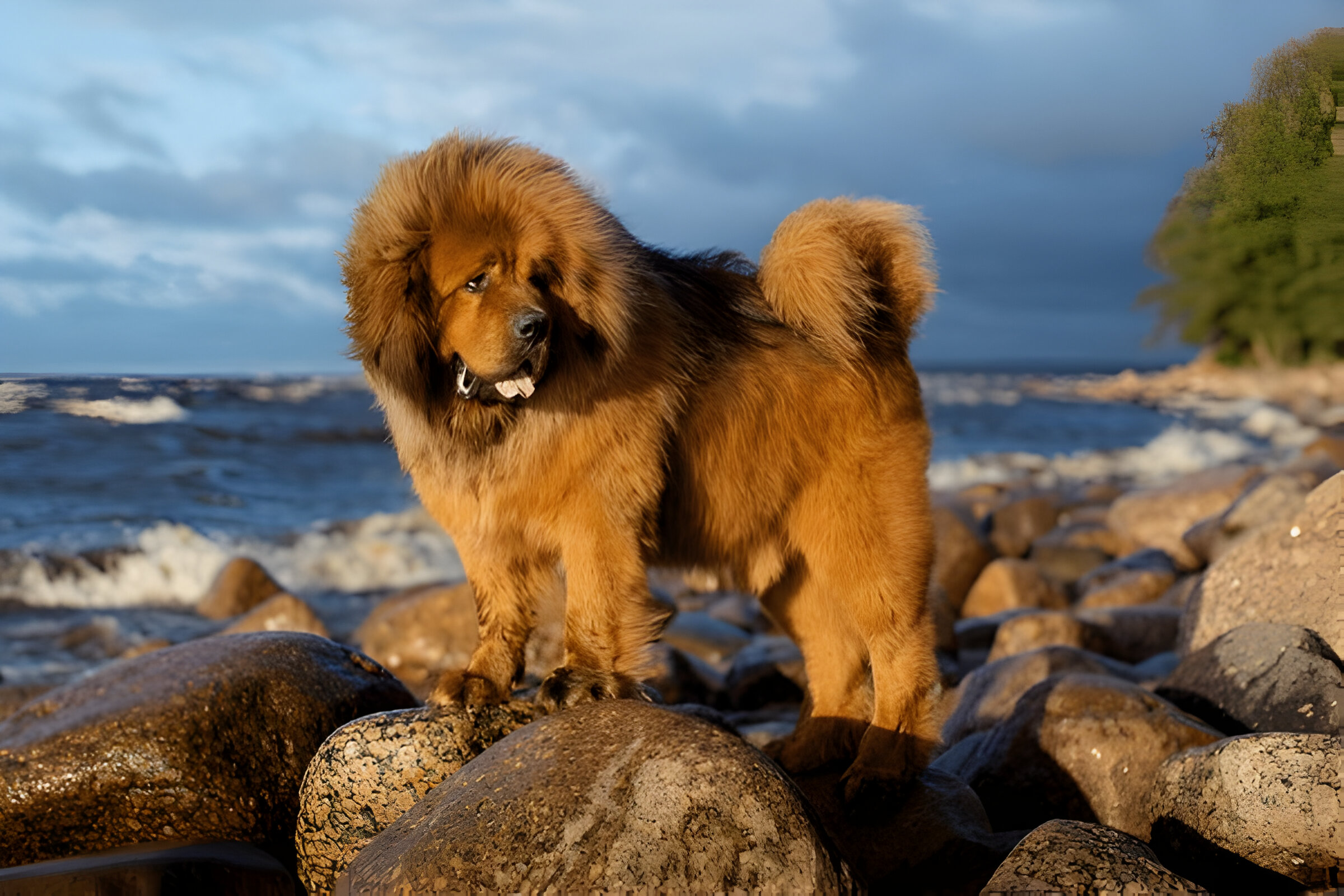Image Credits : Shutterstock
The Tibetan Mastiff stands out as the biggest dog breed in the world, capturing the attention of dog enthusiasts and casual observers alike. Known for their impressive size and powerful presence, these gentle giants have a rich history rooted in the Himalayan mountains. With their thick coats and watchful brown eyes, Tibetan Mastiffs embody a unique blend of strength and calmness that sets them apart from other large breeds.
As we delve into the world of the Tibetan Mastiff, we’ll explore their physical characteristics, tracing back to their origins in Tibet. We’ll also uncover the temperament that makes these dogs both intimidating and mellow, highlighting their independent nature and reserved demeanor. From their role as guardians to their place in modern families, this article will shed light on why the Tibetan Mastiff continues to fascinate dog lovers worldwide.
Physical Characteristics of the Tibetan Mastiff
Size and Weight
The Tibetan Mastiff stands out as one of the biggest dog breeds in the world. Males typically reach heights of 26 to 29 inches at the shoulder, while females stand between 24 and 27 inches tall. Their weight is equally impressive, with males tipping the scales at 90 to 150 pounds and females weighing between 70 and 120 pounds. These measurements contribute to their powerful and substantial appearance.
Coat and Colors
Tibetan Mastiffs have a double coat consisting of a thick, wooly undercoat and coarse guard hair. This coat requires minimal grooming for most of the year, with some light shedding occurring in spring or summer. The breed comes in a variety of colors, including black, brown, blue/grey, and gold. Some Tibetan Mastiffs may have tan markings or a white star on the chest. The coat colors can range from rich mahogany to pale biscuit in brown dogs, and from silver to charcoal gray in blue-coated individuals.
Facial Features
The Tibetan Mastiff’s head is broad, featuring high-set, V-shaped ears that fall forward. Their expressive brown eyes contribute to a noble and sagacious expression. Some individuals may have droopier eyelids, which can predispose them to certain eye conditions. The breed’s mane gives them a dignified, lion-like appearance, which is particularly noticeable in males.
History and Origin of the Tibetan Mastiff
Ancient Tibetan Roots
The Tibetan Mastiff’s history is shrouded in mystery, with its origins dating back to ancient times in the Himalayan mountains and Central Asian plains. These large guardian dogs have been an integral part of Tibetan culture for centuries. Tibetan nomads have bred these dogs since time immemorial, and they were often given to high lamas to guard the great monasteries of Tibet. Interestingly, Buddhist Tibetans believe that Tibetan Mastiffs possess the souls of monks and nuns who did not reach Shambhala, their heavenly paradise.
Breed Development
Many experts consider the Tibetan Mastiff to be the foundation stock from which most modern large working breeds have developed. This includes all mastiff or Molosser breeds and mountain dogs. The earliest written accounts place a large dog in China around 1100 BC, with skulls of large dogs dating back to the stone and bronze ages. It’s believed that ancestors of today’s Mastiff breeds accompanied the armies of ancient civilizations, including the Assyrians, Persians, Greeks, and Romans. These dogs also traveled with Attila the Hun and Genghis Khan as far west as Europe.
Introduction to the West
Prior to the early 1800s, Tibet remained largely inaccessible to Westerners, limiting knowledge about Tibetan dogs. In 1800, Captain Samuel Turner mentioned encountering huge dogs in Tibet, but provided no detailed description. A significant milestone occurred in 1847 when Lord Hardinge, Viceroy of India, sent a “large dog from Tibet” named “Siring” to Queen Victoria. This event marked the breed’s introduction to the West. In 1873, The Kennel Club in England officially designated the “large dog from Tibet” as the “Tibetan Mastiff” for the first time. Subsequent imports to England and Europe occurred sporadically until 1928, when Colonel and Mrs. Bailey brought four Tibetan Mastiffs from Sikkim, Nepal, and Tibet. This led to the formation of the Tibetan Breeds Association in England in 1931 and the adoption of the first official breed standard by The Kennel Club. Today, while the Tibetan Mastiff is a majestic and historical breed, it’s important to consider various factors, including the best dogs for seniors, when choosing a pet. Breeds that are known for their gentle demeanor and lower maintenance needs can be particularly suitable for older individuals seeking a loyal companion.
Also Read : Slavic Women: Beauty, Tradition, and Modern Perspectives
Temperament and Personality Traits
Guardian Instincts
Tibetan Mastiffs possess strong innate guarding instincts, making them natural protectors. These dogs have a watchful and aloof demeanor, especially around strangers. Their protective nature stems from their historical role as guardians of livestock and monasteries in Tibet. Early training and socialization are crucial to enhance their ability to distinguish real threats from everyday occurrences.
Family Loyalty
Despite their imposing appearance, Tibetan Mastiffs display a gentle and affectionate nature towards their family members. They form deep bonds with those they trust, often showing a soft spot for children. However, due to their large size, supervision is advisable during interactions with young family members. Their loyalty translates into a strong protective instinct, always remaining alert to potential threats to their loved ones.
Independence and Intelligence
Tibetan Mastiffs are known for their independent thinking and high intelligence. They do not respond well to traditional obedience training methods, as they quickly learn tasks and see no need for repetition. These dogs thrive on routine and predictability, preferring to make their own decisions based on instinct. Their independence, combined with their protective nature, requires owners to establish themselves as strong leaders to ensure proper behavior and control.
Conclusion
The Tibetan Mastiff, with its impressive size and rich history, stands as a testament to the enduring bond between humans and dogs. These gentle giants have an influence on both their immediate surroundings and the broader world of canine enthusiasts. Their unique blend of protective instincts, family loyalty, and independent nature makes them a breed that demands respect and understanding. The journey of the Tibetan Mastiff from the Himalayan mountains to homes worldwide showcases the breed’s adaptability and enduring appeal.
As we’ve explored, the Tibetan Mastiff’s physical attributes and temperament set it apart from other large breeds. Their role has evolved from guarding monasteries and livestock to becoming cherished family companions. While they require experienced handling and early socialization, the rewards of sharing life with a Tibetan Mastiff are immense. These dogs continue to captivate and inspire, reminding us of the diverse and fascinating world of canine companions.
FAQs
1. What is the average size and weight of a Tibetan Mastiff?
- Answer: Tibetan Mastiffs are one of the largest dog breeds. Males typically stand between 26 to 29 inches at the shoulder and weigh 90 to 150 pounds. Females usually stand between 24 to 27 inches tall and weigh 70 to 120 pounds.
2. What are the common coat colors of a Tibetan Mastiff?
- Answer: Tibetan Mastiffs come in various colors, including black, brown, blue/grey, and gold. They may also have tan markings or a white star on their chest. Coat colors can range from rich mahogany to pale biscuit in brown dogs and from silver to charcoal gray in blue-coated individuals.
3. What is the historical significance of the Tibetan Mastiff?
- Answer: The Tibetan Mastiff has a rich history dating back to ancient Tibet, where it was used as a guardian of livestock and monasteries. It is believed to be the foundation stock for many modern large working breeds and has traveled with historic figures like Attila the Hun and Genghis Khan.
4. When was the Tibetan Mastiff introduced to the Western world?
- Answer: The breed was introduced to the West in 1847 when Lord Hardinge sent a Tibetan Mastiff named Siring to Queen Victoria. The breed was officially named “Tibetan Mastiff” by The Kennel Club in England in 1873.
5. What is the temperament of a Tibetan Mastiff?
- Answer: Tibetan Mastiffs are known for their strong guarding instincts and aloofness with strangers. They are loyal and affectionate with their family members, including children, though their large size requires supervision around young kids. They are also highly intelligent and independent, requiring consistent leadership and training.
6. How should a Tibetan Mastiff be trained?
- Answer: Tibetan Mastiffs require early training and socialization to manage their guarding instincts and ensure they can differentiate between real threats and everyday occurrences. Due to their independent nature, they may not respond well to traditional obedience training methods, so it’s important to establish oneself as a strong leader.
7. How much grooming does a Tibetan Mastiff require?
- Answer: The Tibetan Mastiff’s double coat requires minimal grooming for most of the year, with light shedding occurring in spring or summer. Regular brushing can help manage shedding and keep their coat in good condition.
8. Are Tibetan Mastiffs good with children?
- Answer: Tibetan Mastiffs can be gentle and affectionate with children they are familiar with, but due to their large size and strength, supervision is recommended during interactions with young kids to prevent accidental injuries.




